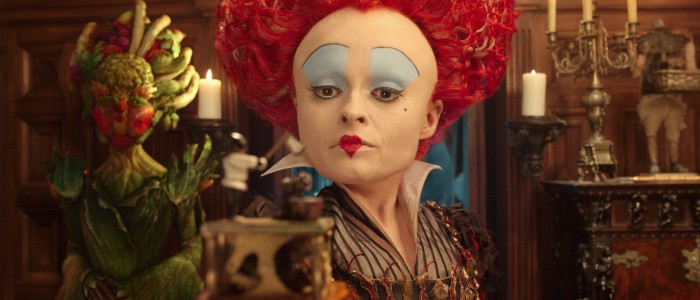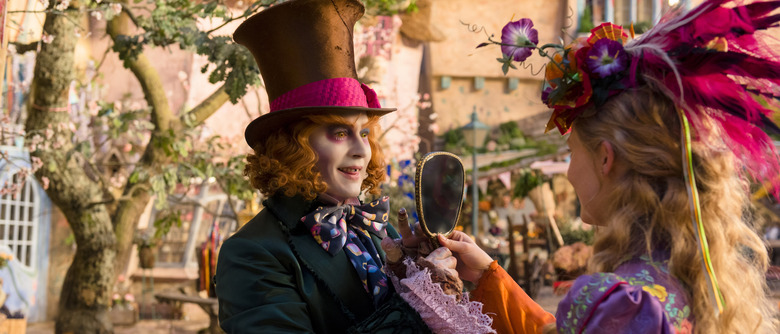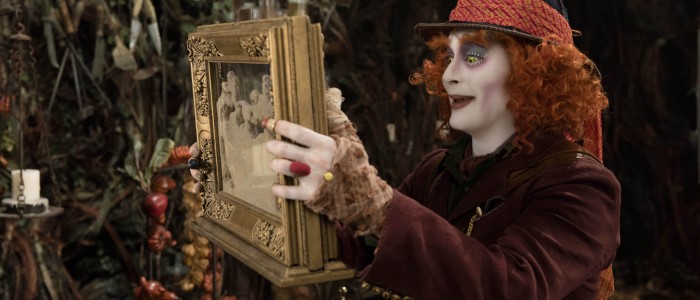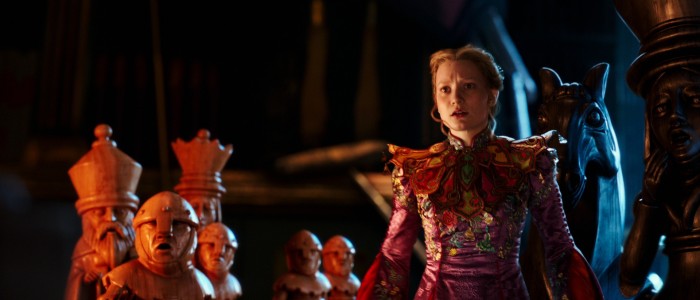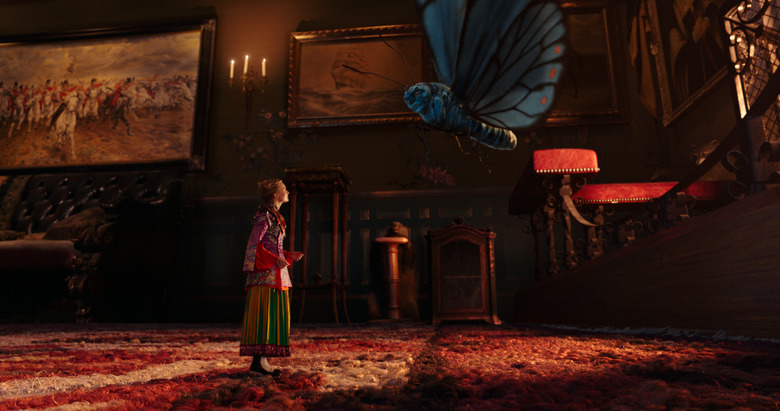'Alice Through The Looking Glass' Trailer & Preview: Alice Crosses Oceans Of Time To Save Past, Present, And Future
It's been over six years since our last trip to Underland. In 2010, director Tim Burton reimagined Lewis Carroll's classic story with his box office hit, which made over a billion dollars worldwide. Burton decided not to return for the upcoming sequel, Alice Through the Looking Glass. Instead, director James Bobin (The Muppets Movie) has stepped in to show a new side of both Alice and Underland.
We were recently invited to see footage from the sequel, in addition to participating in roundtable interviews with the filmmakers. Check out our Alice Through the Looking Glass preview below, and watch the latest trailer, below.
Alice Through the Looking Glass Trailer
A Slightly New (and More Comedic) Vision
Alice Through the Looking Glass doesn't present a wildly different version of Underland, based on the footage Disney previewed, but it's coming from a new and fresh perspective — James Bobin's. The filmmaker, who also worked on Flight of the Conchords and Da Ali G Show, has a firm grasp on comedy and tone. The clips we saw didn't entirely feel like more of the same, which is a good thing, especially if you're not a fan of Burton's picture.
"I felt there was something I could bring to it," Bobin told a group of us. "I've always loved Lewis Carroll, and I've always felt he was this kind of... my background is in comedy, as you all know, and I thought I could bring that comedic element to it, because Lewis Carroll was a guy who was, sort of, a surrealist satirist." Bobin added the sequel is slightly lighter than the first film, but it's not without a sense of danger and stakes.
Don't Expect Nothing But CGI This Time
The sequel takes place a few years after the events of Burton's picture. At the beginning of the film, Alice (Mia Wasikowska) has been on a one-year journey captaining her father's ship, before she has to go on and travel through time to assist the Mad Hatter. The Alice we saw in this first clip was more confident and more adventurous than when we last saw her. Alice and her crew are on the run in the middle of the sea, in a fairly CG-heavy set piece, which nicely establishes how she's evolved since Alice in Wonderland.
Of course, plenty of CGI is expected from this series, as it is the aesthetic Burton established with the first movie. But the world felt slightly more tangible this time around, at least in the footage we saw. With the sequel, Bobin isn't relying completely on CG. "On this film, we had a few more sets than the last one," Wasikowska said. "Whenever we had a set, it was great. It was really helpful." The ship, for example, was partially built and placed on a gimbal.
Bobin, speaking for himself, was drawn to the challenges that come with working with this amount of CGI. "One of the reasons I did the film is because the first two movies [I did] were so in-camera, that I really wanted to do something, as you generally do in life, that's a challenge and it's interesting to you. It is a complicated film to make, because there's live action and CG, so you're basically making two sorts of movies: you're making a live-action feature, and then you're making an animated feature on top of it. You're making the film all the time. Generally you shoot, come back and edit, do what you can, and this is one whereby you're constantly working, constantly filming, and constantly... I feel like my brain has never stopped for three years [laughs], and it's great. Only at the point in which they say, 'This shot cannot make the release date,' you stop working. That's it. That's really it. It's an amazing thing, because it means you're on all the time."
A Fight for the Past, Present, and Future
Speaking of time, another clip featured Alice returning to Underland, discovering that the Mad Hatter (Johnny Depp) has gone mad, thanks to the past. It's a more exposition-heavy scene, setting up what's to come. The clips that followed gave a greater understanding of what the film is about — the past, present, and future.
The Red Queen (Helena Bonham Carter) wants to control Underland through time, which only Time (Sacha Baron Cohen) can help her do. That's right — the villain is a physical embodiment of time, and he happens to be madly in love with the Red Queen. "The thing is, when I read the first draft, I liked it, but I really liked in the book, Alice in Wonderland, when Alice first meets Mad Hatter, he says to her: 'We are stuck at this tea party. I have been since last March, because last March time Time and I quarreled. I thought, Oh, so in Lewis Carroll's mind, time is a person. That is a great idea for any antagonist: time personified. Of course, the next thought is you don't want him to be a straight up bad guy — and we already have the Red Queen, so we don't need one — so I thought it'd be interesting if he was this omnipotent being but he's also sort of a twit."
Bobin's sense of humor shined more in the sequences we saw later, both of which featured Time, who truly is a twit. Even as someone who found Johnny Depp's Mad Hatter slightly off-putting, I thought the character's banter with Time to be one of the highlights of the footage. Instead of a physical confrontation between the two, we'll instead see two idiots trying their best outsmart each other.
"There's no one better than playing the confident idiot trope than Sacha Baron Cohen," Bobin added with a laugh. "When I was thinking of Time and what he was going to be, I very much had Sacha in mind — because he has an innate sense of comedy, but at the same time, you like him. Borat has the most outrageous opinions and is a terrible person, but everybody loves Borat. You want to hangout with Borat. Again, he's very good at bringing a sense of vulnerability to the character. Time has this Achilles' heel: he's kind of lonely." The Red Queen, of course, takes advantage of that loneliness.
Throwing Out Time Travel Rules
Time travel is sometimes difficult to make sense of in a film. Paradoxes are almost always inevitable with time travel movies. Sometimes the more rules there are, the more complicated things get. "We kept it very simple and basically avoided most rules that you can," Bobin said. "It's a hard thing, really. On this one, it's the idea you cannot change the past — because the past is the past, it is what it is. All you can do is probably learn from being there [in the past]. In most time travel movies, you change the past, and whatever you do then, it'll have an effect and there's the butterfly effect, a common trope in movies. This gave us license to do something different. Also, in terms of design in most time travel movies, stuff around you changes, but for Underland, you can do different stuff. In this world, time is a geographical expression: you literally travel through time, the oceans of time. The past is a long way away. Alice has to journey through time to get to the past — and I thought that was a really cool idea."
Telling a Story Lewis Carroll Would've Enjoyed
Ultimately, that is Bobin's hope for the film. The director had to take liberties with the story, which is quite different from the film, but he wanted to stay faithful to what made Lewis Carroll's stories special. Bobin explained the greatest challenge of the film is it's a "very complex story," and while he wanted to make a movie his own daughter could comprehend, he also didn't want to completely simplify Carroll's writing.
"The Looking Glass, I love as a book, but as a narrative, it's a very strange book," the director said. "Charles Dodgson — who was obviously Lewis Carroll in the real world — was a mathematician at Oxford, who specialized in pure math and unusual algorithms; he really wrote children's books as a side project, and then it took off. As a consequence for his own personal reason, he wrote books that made sense to him, mathematically. The Looking Glass is eight chapters long, because a chest board is eight squares long. In the book, Alice is a pawn, but by the end, she is a Queen, because she gets to the other side. For him, it was a personal exercise in mathematical equations and that sort of thing. The narrative itself is rather interesting, because there's no real cause and effect or through line — things just happen. That's hard to make into a film, but at the same time, I wanted to pay tribute to the tone, sense, grammar, and world of that book, while having a story that works for an hour and a half."
***

